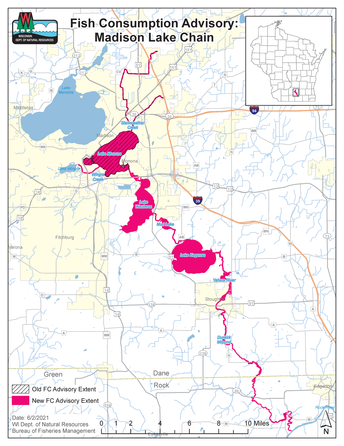DNR: Fish from Yahara chain of lakes contaminated with PFAS; anglers warned to limit consumption
Chris Hubbuch, Wisconsin State Journal
Health officials are warning anglers to limit consumption of fish from all but two of Madison’s lakes after new test results revealed high levels of toxic “forever chemicals” known as PFAS.
The state Department of Natural Resources announced the warnings Wednesday based on tests of fish collected last year from the Yahara River chain of lakes.
Based on new test results, the DNR has expanded existing advisories for Starkweather Creek and Lake Monona to include all waters downstream to the Rock River, including lakes Waubesa and Kegonsa.

The DNR released data showing fish had levels of one compound, PFOS, above the health standard recommended for limiting consumption by an interstate commission for the Great Lakes region. PFOS has been linked to cancer, high cholesterol and decreased immunity.
Nathan Kloczko, site evaluation program coordinator for the Department of Health Services, said people who’ve been eating fish from the lakes may want to talk to their doctors about individual health concerns.
Kloczko said the consumption advisories seek to balance the risks of contaminants such as PFOS against the health benefits of eating fish.
“Fish are an excellent source of lean protein and omega fatty acids,” he said. “The risk assessments … take all of that into account.”
The DHS recommends eating crappie, largemouth bass, northern pike and walleye no more than once a month. The agency says it is safe to eat bluegill, yellow perch and pumpkinseed once a week.
Data provided by the DNR show PFOS concentrations were all below the level considered safe to eat by the Great Lakes Consortium for Fish Consumption Advisories, although average levels were at or above what the New Jersey Department of Environmental Protection has recommended for children and women of childbearing age.
Wisconsin’s health advisories are uniform across all ages, which environmental advocate Maria Powell calls “problematic.” Powell also criticized the state for focusing only on PFOS and not the thousands of other less-studied compounds.
“This ‘one-size-fits-all’ approach does not protect everyone in the population, especially the most vulnerable,” Powell said. “People are ingesting all of the PFAS in the fish, not just one at a time. They all add to the toxicity.”
While PFOS was not found at dangerous levels in fish from lakes Mendota and Wingra, a once-a-month advisory remains in effect for carp because of high PCB levels. The DNR publishes advisories for specific species from around the state in an annual guidebook available on the agency website.
Anglers concerned
Jack Hurst, an active member of the Yahara Fishing Club since 1953, said PFAS is a growing concern for the club, which was formed to protect the rights of anglers to use the lakes.
“I don’t eat ‘em out of Monona anymore,” Hurst said.
Angler and environmentalist Touyeng Xiong called the news disheartening.
Xiong said he and his father used to eat crappie from Monona Bay but stopped after learning about PFAS contamination.
He worries that others are unaware or unconcerned by the advisories.
“I still see people pretty regularly fishing there,” Xiong said. “I always wonder if they know of the current conditions.”
Early last year, officials warned anglers to limit consumption of certain fish from Lake Monona after tests showed elevated levels of PFAS in fish from the lake and Starkweather Creek.
The DNR has since issued PFAS consumption advisories for smelt from Lake Superior and trout from Silver Creek in the Fort McCoy Army base in Monroe County. PFAS advisories were previously in place for fish caught in three pools of the Mississippi River.
In January, the DNR said it had found PFAS compounds in all five Madison lakes — in some cases above proposed surface water standards — but did not provide guidance on the safety of fish caught there.
The DNR has not identified a source for the contamination.
Still searching
It’s been almost three years since the agency ordered the city of Madison, Dane County and the Wisconsin National Guard to clean up PFAS contamination sites at the airport where firefighters trained for decades with fluorinated foams that contaminated soil and groundwater. PFAS have also been found in water draining from airport storm sewers into Starkweather Creek.
That cleanup has not begun, but earlier this year the DNR approved a plan by all three entities to further investigate the source of the contamination.
The plan aims to find where PFAS-contaminated groundwater is seeping into the stormwater system and seal up leaky pipes. It also calls for additional sampling of Starkweather Creek to get a better idea of where PFAS are coming from.
The National Guard says it has received authorization from the Department of Defense to move forward with an investigation through the federal Superfund, a process that could take 13 years or more.
“People just not doing their jobs is what it amounts to,” Hurst said. “They know about it and they don’t do anything about it.”
Democratic lawmakers called on Republican lawmakers to pass legislation requiring the DNR to establish enforcement standards for PFAS in air, water and soil and to hold polluters responsible for cleanup.
The bill, reintroduced this spring after Republicans denied it a vote in the last session, has support from environmental and public health organizations but not manufacturing and industrial groups.
“Water is life, and addressing PFAS should not be a partisan issue,” said state Sen. Melissa Agard, D-Madison. “It affects the health of people in blue and red districts.”

